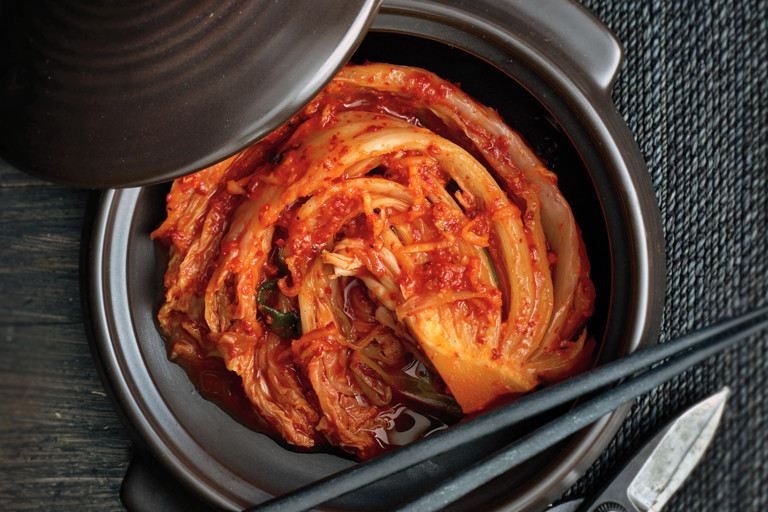Cabbage kimchi
- Side
- medium
- Makes 8
- 60 minutes
Judy Joo shares her fantastic kimchi recipe, the pickled cabbage thought of as the national dish of Korea. Don't be intimidated by the idea of fermenting cabbage at home, Judy's recipe takes you through the whole process, step-by-step, resulting in authentic Korean kimchi with the perfect balance of sour, sweet and spicy flavour. This recipe will make about 4.5 litres of kimchi.
Aside from barbecue, kimchi is probably the dish most synonymous with Korean cuisine. This fiery red, funky, fermented cabbage is on the table every meal – breakfast, lunch and dinner, 365 days a year. It is one of the cornerstones of Korean cooking, and Koreans consider it vital to their daily diet.
This recipe is an adaption of the one we use at my restaurant, Junjuu. Kimchi making may look daunting, but don’t worry, it’s really very straightforward. You’ll just need to have one or two very large bowls for the brining of the cabbage and a large container to ferment it in. Also, I highly recommend that you wear plastic or latex gloves while smearing the chilli paste onto the cabbage leaves. Otherwise, your hands will be tingling afterwards and the odour, while delicious, will linger on your skin.
Many Korean households purchase pre-made kimchi these days, and you can certainly do that and use it wherever kimchi is called for in my recipes, but please do try making this at least once.
While large glass jars or Korean earthenware containers are preferred for storing kimchi, they’re not always easy to find. Look in the housewares section of Asian markets for glass or plastic kimchi containers, which have become popular. You can also use any sturdy BPA-free plastic or other nonreactive containers with a total capacity of 4.5 litres (8 pints) for the kimchi.
Recipe extracted from Korean Food Made Simple: Easy and Delicious Korean Recipes to Prepare at Home by Judy Joo (Jacqui Small, £22). Photography by Jean Cazals
Ingredients
Metric
Imperial
Cabbage kimchi
- 2l warm water
- 225g of coarse sea salt
- 2.5kg Napa cabbage, bottom trimmed, wilted and tough outer leaves discarded and rinsed well
- 2 small onions, roughly chopped
- 12 dried shiitake mushrooms
- 10 dried anchovies, (myulchi) head and guts removed
- 6 spring onions, roughly chopped
- 64 garlic cloves, 8 crushed and the rest left whole
- 1 sheet of dried seaweed, (25cm long)
- 250g of gochugaru, (Korean chilli flakes)
- 14 tbsp of fish sauce
- 10 tbsp of salted shrimp, (saewujeot), rinsed
- 4 tbsp of sugar
- 1 knob of fresh ginger, (18cm), peeled and chopped
- 3 carrots, julienned
- 12 spring onions, cut into 5cm pieces
- 200g of white radish, or mooli, peeled and julienned
Method
Get in touch
Please sign in or register to send a comment to Great British Chefs.


